
Applications and Investigations in Earth Science (9th Edition)
9th Edition
ISBN: 9780134746241
Author: Edward J. Tarbuck, Frederick K. Lutgens, Dennis G. Tasa
Publisher: PEARSON
expand_more
expand_more
format_list_bulleted
Textbook Question
Chapter 13, Problem 11LR
What is the date illustrated by the diagram in Figure 13.10?

Expert Solution & Answer
Learn your wayIncludes step-by-step video

schedule04:26
Students have asked these similar questions
Which oxidants oxidize NO to NO 2 (select all that apply)?
03
OH
HO2
RO2
Which oxidants must oxidize NO to NO 2 in order to lead to net formation of ozone (select all
that apply)?
☐ 03
☐ OH
U
HO2
RO2
Exercise Ten / Geologic Time
177
d. Based on the ages of the rock layers in outcrop 1, identify an unconformity. Remember that an unconformity is
a break in the rock record. Draw a wavy line on the figure to represent the unconformity.
Ginkgo
Period
Ginkgo
Lepidodendron
Dimetrodon
Period
Tyrannosaurus
Calamites
Inoceramus
Period
Lepidodendron
Rhodocrinites
Archimedes
Eurypterus
Period
Sharks
Period
Phacops
Agnostus
Outcrop 1
Period
Period
Ichthyosaurus
Period
Sharks
Ceratites
Period
Paleolimulus
A Figure 10.17 Sequences of sedimentary rock layers to accompany Question 7.
10.8 Numerical Dating with Radioactivity
■ Explain the principle of radiometric dating, including half-life, parent isotope,
and daughter product.
Radioactivity has provided a reliable means for calculating the numerical (absolute) age of
rocks, a procedure called radiometric dating. Radioactive isotopes, such as uranium-238,
emit particles from their nuclei that we call radiation. Ultimately, the process of decay…
Chapter 13 Solutions
Applications and Investigations in Earth Science (9th Edition)
Ch. 13.1 - Prob. 1ACh. 13.1 - Prob. 2ACh. 13.1 - Prob. 3ACh. 13.1 - Prob. 4ACh. 13.1 - Prob. 5ACh. 13.1 - Prob. 6ACh. 13.1 - Assume that the length of line X-Y represents 100...Ch. 13.1 - Prob. 8ACh. 13.1 - Prob. 9ACh. 13.1 - Prob. 10A
Ch. 13.2 - Prob. 1ACh. 13.2 - Use Figure 13.4, which shows the position of Earth...Ch. 13.2 - Which name season is used to describe the June...Ch. 13.2 - On June 21-22, are the Suns noon rays directly...Ch. 13.2 - What latitude receives the most intense solar...Ch. 13.2 - Would you look.toward the north or south to see...Ch. 13.2 - Use the circle of illumination on the globe...Ch. 13.2 - Using Table 13.1, provide the length of daylight...Ch. 13.2 - What name season is used to describe the December...Ch. 13.2 - At which parallel of latitude-the Tropic of...Ch. 13.2 - Prob. 11ACh. 13.2 - If you lived at the equator on December 21- 22,...Ch. 13.2 - Prob. 13ACh. 13.2 - Prob. 14ACh. 13.2 - Prob. 15ACh. 13.2 - Prob. 16ACh. 13.2 - Prob. 17ACh. 13.2 - Prob. 18ACh. 13.2 - Prob. 19ACh. 13.2 - Prob. 20ACh. 13.3 - Prob. 1ACh. 13.3 - Prob. 2ACh. 13.3 - Prob. 3ACh. 13.3 - Prob. 4ACh. 13.3 - Prob. 5ACh. 13.4 - Prob. 1ACh. 13.4 - Prob. 2ACh. 13.4 - Prob. 3ACh. 13.4 - Prob. 4ACh. 13.4 - Prob. 5ACh. 13.4 - Prob. 6ACh. 13.5 - Prob. 1ACh. 13.5 - Prob. 2ACh. 13.6 - Prob. 1ACh. 13.6 - Prob. 2ACh. 13.6 - Prob. 3ACh. 13.6 - Prob. 4ACh. 13.6 - Prob. 5ACh. 13 - Prob. 1LRCh. 13 - How many hours of daylight occur at the following...Ch. 13 - During the winter solstice in the Northern...Ch. 13 - What is the relationship between the angle of the...Ch. 13 - Complete Figure 13.9, showing Earths relationship...Ch. 13 - What causes the intensity and duration of solar...Ch. 13 - What are the maximum and minimum noon Sun angles...Ch. 13 - What are the approximate maximum and minimum...Ch. 13 - Briefly describe how the intensity and duration of...Ch. 13 - On March 22, you view the noon Sun to the south at...Ch. 13 - What is the date illustrated by the diagram in...Ch. 13 - Calculate the noon Sun angle at 30N latitude on...
Additional Science Textbook Solutions
Find more solutions based on key concepts
WHAT IF? Is allopatric speciation more likely to occur on an island close to a mainland or on a more isolated ...
Campbell Biology (11th Edition)
One of the important ideas of thermodynamics is that energy can be transferred in the form of heat or work. Im...
Chemistry: The Central Science (14th Edition)
Why are the top predators in food chains most severely affected by pesticides such as DDT?
Campbell Essential Biology with Physiology (5th Edition)
Match each of the following items with all the terms it applies to:
Human Physiology: An Integrated Approach (8th Edition)
Draw the structure of the monomer or monomers used to synthesize the following polymers, and indicate whether e...
Organic Chemistry (8th Edition)
57. Which elements are alkaline earth metals?
a. sodium
b. aluminum
c. calcium
d. lithium
Introductory Chemistry (6th Edition)
Knowledge Booster
Similar questions
- Dike K H Fault L Figure 10.12 Geologic block diagram of a hypothetical area. C Youngest B Intrusion J Oldest "arrow_forwardChrome File Edit View History 0 O ↑ X O SIS Ω 4-511 6 Bookmarks Profiles Tab Window Help X 4-510 X 4-509 + cl.castlelearning.com/Review/CLO/Student/Assignment/Questions?assignmentID=13205009&tid=9976762 0 Qad c 4-511 Select Language 98 Mon May 5 5:26 PM Relaunch to update CED Sal Salvatore Burgio 5009 Which cross section best represents the pattern of sediments deposited on the bottom of a lake as the velocity of the stream entering the lake steadily decreased? -Top 2. esc Bottom Top Bottom Top Bottom Top Bottom Submit Answer Zoom: Standard Note Bookmark Eliminator Highlighter Line Reader Reference Calculator Ruter Protractor MAY LO XA tv N Aa MacBook Pro C D Search or type URL ABGAB 1 2 # $ % & 3 4 5 6 7 8 00 Q W E R T Y U tab A S D F G caps lock shift H H ( 9 0 O + 11 Listen P [ ] J K L ? Z X C V B N M H command option L H fn control option command delete return shiftarrow_forwardI need help with part b and c. I don't want an explanation I need the actual graph, because it's hard to understand an explanation without showing what they mean.arrow_forward
- I need help with part b and c. I don't want an explanation I need the actual graph preferably broken down, because it's hard to understand an explanation without showing what they mean.arrow_forwardI need help with part b and c I don't know how to draw it.arrow_forwardI need help on part barrow_forward
- I need help with part carrow_forwardCan someone one sketch this and show me step by step how they did it.arrow_forward4. What is the geologic range of the fossil shown in Figure 10.15? From the Ordovician period through the Permian period. 5. What is the geologic range of the fossil shown in Figure 10.16? From the Cambrian period through the Permian period. 6. Imagine that you have discovered a rock outcrop that contains the fossils identified in Questions 4 and 5. What is the geologic range of this rock?From theperiod through the period.arrow_forward
- 4. What is the geologic range of the fossil shown in Figure 10.15? From the period through the period5. What is the geologic range of the fossil shown in Figure 10.16? From the period through the period.arrow_forwardACTIVITY 10.6 Types of Fossils Pg 174 1. Refer to Figure 10.13. Which photo(s) (A-1) best illustrate(s) the methods of fossilization or fossil evidence listed below? (Photos/letters may be used more than once.)Permineralization: The small internal cavities and pores of an original organism that are filled with precipitated mineral matter. Photo(s):Cast: The space once occupied by a dissolved shell or other structure that is subsequently filled with mineral matter. Photo(s):Carbonization: Preservation that occurs when fine sediment encases delicate plant or animal forms and leaves a residue of carbon, Photo(s):Impression: A replica of an organism, such as a leaf, left in fine-grained sedimentary rock. Photo(s):Amber: Hardened resin of ancient trees that preserved delicate organisms such as insects. Photo(s):Indirect evidence: Traces of prehistoric life but not the organism itself. Photo(s):arrow_forwardACTIVITY 10.7 Fossils as Time Indicators Pgs 175-176Use Figure 10.14, page 175, to complete the following. 1. What is the geologic range of plants that belong to the group Ginkgo?From theperiod through theperiod. 2. What is the geologic range of Lepidodendron, an extinct coal-producing plant?From theperiod through theperiod. 3. Imagine that you have discovered an outcrop of sedimentary rock that contains fossil shark teeth and fossils of Archimedes. In which time periods might this rock have formed?From theperiod through theperiod.arrow_forward
arrow_back_ios
SEE MORE QUESTIONS
arrow_forward_ios
Recommended textbooks for you
 Applications and Investigations in Earth Science ...Earth ScienceISBN:9780134746241Author:Edward J. Tarbuck, Frederick K. Lutgens, Dennis G. TasaPublisher:PEARSON
Applications and Investigations in Earth Science ...Earth ScienceISBN:9780134746241Author:Edward J. Tarbuck, Frederick K. Lutgens, Dennis G. TasaPublisher:PEARSON Exercises for Weather & Climate (9th Edition)Earth ScienceISBN:9780134041360Author:Greg CarbonePublisher:PEARSON
Exercises for Weather & Climate (9th Edition)Earth ScienceISBN:9780134041360Author:Greg CarbonePublisher:PEARSON Environmental ScienceEarth ScienceISBN:9781260153125Author:William P Cunningham Prof., Mary Ann Cunningham ProfessorPublisher:McGraw-Hill Education
Environmental ScienceEarth ScienceISBN:9781260153125Author:William P Cunningham Prof., Mary Ann Cunningham ProfessorPublisher:McGraw-Hill Education Earth Science (15th Edition)Earth ScienceISBN:9780134543536Author:Edward J. Tarbuck, Frederick K. Lutgens, Dennis G. TasaPublisher:PEARSON
Earth Science (15th Edition)Earth ScienceISBN:9780134543536Author:Edward J. Tarbuck, Frederick K. Lutgens, Dennis G. TasaPublisher:PEARSON Environmental Science (MindTap Course List)Earth ScienceISBN:9781337569613Author:G. Tyler Miller, Scott SpoolmanPublisher:Cengage Learning
Environmental Science (MindTap Course List)Earth ScienceISBN:9781337569613Author:G. Tyler Miller, Scott SpoolmanPublisher:Cengage Learning Physical GeologyEarth ScienceISBN:9781259916823Author:Plummer, Charles C., CARLSON, Diane H., Hammersley, LisaPublisher:Mcgraw-hill Education,
Physical GeologyEarth ScienceISBN:9781259916823Author:Plummer, Charles C., CARLSON, Diane H., Hammersley, LisaPublisher:Mcgraw-hill Education,

Applications and Investigations in Earth Science ...
Earth Science
ISBN:9780134746241
Author:Edward J. Tarbuck, Frederick K. Lutgens, Dennis G. Tasa
Publisher:PEARSON

Exercises for Weather & Climate (9th Edition)
Earth Science
ISBN:9780134041360
Author:Greg Carbone
Publisher:PEARSON

Environmental Science
Earth Science
ISBN:9781260153125
Author:William P Cunningham Prof., Mary Ann Cunningham Professor
Publisher:McGraw-Hill Education

Earth Science (15th Edition)
Earth Science
ISBN:9780134543536
Author:Edward J. Tarbuck, Frederick K. Lutgens, Dennis G. Tasa
Publisher:PEARSON

Environmental Science (MindTap Course List)
Earth Science
ISBN:9781337569613
Author:G. Tyler Miller, Scott Spoolman
Publisher:Cengage Learning

Physical Geology
Earth Science
ISBN:9781259916823
Author:Plummer, Charles C., CARLSON, Diane H., Hammersley, Lisa
Publisher:Mcgraw-hill Education,